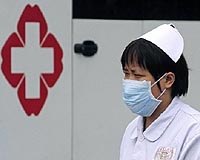| . |  |
. |
Paris (AFP) Aug 25, 2009 More than half the fatalities from swine flu have been among young adults, according to one of the first surveys to gather mortality data from across the globe for the new A(H1N1) virus. The analysis of 574 pandemic deaths from 28 countries through mid-July, released this week, also found that being diabetic or obese significantly boosted the risk of dying. Neither children nor the elderly are as vulnerable as initial reports indicated, found the study, published by Eurosurveillance, the monitoring arm of the European Centre for Disease Prevention and Control. "Most deaths (51 percent) occurred in the age group of 20-to-49 year-olds, but there is considerable variation depending on country or continent," the researchers reported. Only 12 percent of those who died were 60 or older. All of these features -- high mortality among young adults and the obese, but not the very young or elderly -- are sharply different than for the seasonal flu. More than 90 percent of deaths from seasonal flu -- which claims 250,000 to 500,000 lives annually according to the WHO -- are in people over 65. By contrast, with the pandemic H1N1, "the elderly seem to be protected from infection to some extent, perhaps due to previous exposure to similar strains," the study conjectured. Persons born before 1957, other studies have suggested, were almost certainly exposed to the milder seasonal A(H1N1) viruses that evolved from the terrible pandemic of 1918, which left some 40 million dead. With the 2009 strain, "when infection does occur, however, the percentage of deaths in elderly cases seems to be higher that in others." One common target across both pandemic and season strains is pregnant women, according to the study, led by Philippe Barboza of the French Institute for Public Health Surveillance. On Tuesday, the European Union said pregnant women should have priority in the distribution of vaccines, along with health workers and people with underlying health problems. The data underlying the study also suggests that about six people die for every 1,000 infections, two or three times the rate of seasonal flu, but far less than the deadly pandemic of 1918. The researchers caution, however, that it is far too early to calculate the "case-fatality ratio" (CFR) with much accuracy. "Evaluating CFR during a pandemic is a hazardous exercise. Aside from the issue of whether or not a death has been caused by the influenza infection, cases tend to be detected initially among severely ill patients with a higher probability of dying," they conclude. This leads to an over estimation of how lethal a virus is, they note. Swine flu first erupted in Mexico in April, and has since swept across the globe, infecting hundreds of thousands and leaving more than 1,800 dead, according to the World Health Organisation.
earlier related report There was no call for children to be prioritised. A previous idea to include young people in the list of those to be vaccinated first "was abandoned", an EU source said, without giving a reason. "All persons from six months old with underlying chronic conditions (e.g. chronic respiratory diseases; chronic cardiovascular diseases and persons with congenital or acquired immunodeficiency)," should be vaccinated first, the experts from the 27 EU nations said in a written statement. Those with the most severe symptoms should be at the head of the queue, they added. Pregnant women and "health care workers" were the other two categories prioritised by the European Union Health Security Committee and the Early Warning and Response authorities. The experts, who thus backed proposals from the European Commission, stressed that "it is the responsibility and mandate of each (EU) member state to develop a vaccination strategy for influenza A(H1N1)", known as swine flu. "The priority groups identified... are indicative and countries may wish to adapt the prioritisation in line with their epidemiology, health services provisions and resources," the experts agreed. The approach may also need to be changed "as the pandemic progresses". EU health experts had already declared that there is no point in pre-emptive school closures or delaying the start of the new term in order to tackle swine flu. Share This Article With Planet Earth
Related Links Epidemics on Earth - Bird Flu, HIV/AIDS, Ebola
 Give flu vaccine to nurses, chronic sick first: EU experts
Give flu vaccine to nurses, chronic sick first: EU expertsBrussels (AFP) Aug 25, 2009 Pregnant women, health workers and people with underlying health problems should receive swine flu vaccines ahead of the rest of the population, EU experts recommended Tuesday. There was no call for children to be prioritised. A previous idea to include young people in the list of those to be vaccinated first "was abandoned", an EU source said, without giving a reason. "All persons ... read more |
|
| The content herein, unless otherwise known to be public domain, are Copyright 1995-2009 - SpaceDaily. AFP and UPI Wire Stories are copyright Agence France-Presse and United Press International. ESA Portal Reports are copyright European Space Agency. All NASA sourced material is public domain. Additional copyrights may apply in whole or part to other bona fide parties. Advertising does not imply endorsement,agreement or approval of any opinions, statements or information provided by SpaceDaily on any Web page published or hosted by SpaceDaily. Privacy Statement |